Journal of Physical Chemistry & Biophysics
Open Access
ISSN: 2161-0398
ISSN: 2161-0398
Review Article - (2022)Volume 12, Issue 4
Since the birth of physics, our understanding of force has gradually deepened, and the exploration of gravity, electromagnetism, weak force and strong force has continued to deepen. However, a troubling question remains unresolved: The internal connection and unity of these four forces.
This paper first explains the theory of the origin of force from a new perspective, explaining that the origin of all forces is caused by the “missing of energy in the time dimension” (non-conservation in a certain period of time), and constructs a unified theory of force on this basis. Then, through the unified theory of force, the following phenomena are reinterpreted: (1) The common origin of the inverse square law of gravitation and electromagnetic force; (2) The origin of the repulsive force of electrons and protons at small distances; (3) The mystery of the rotation curve of galaxies and the new explanation of “dark matter”; (4) Explain the origin of the magnetic field; (5) Predict that moving magnets have the same radiation effect as charged particles (electron magnetic moments also have radiation effects); (6) Reinterpret Maxwell’s displacement current; (7) Reinterpret synchrotron radiation and bremsstrahlung; (8) Explain that the strong and weak forces are short-range forces; (9) Predict the true structure of black holes and the origin of gravitational waves;(10) Modifications to the Theory of Gravity. Through the unified theory, we will be able to better understand the mechanism of gravity, electromagnetic force, weak force and strong force.
Unified theory of force; Gravitation; Electromagnetic force; Inverse square law; Galaxy rotation curve; Maxwell displacement current
For the explanation of charged particle radiation, we have explained in another article that it may be problematic to explain it by time effect in special relativity [1], and the author has also argued that we can actually explain relativistic effect without time delay and length contraction [2], so how can we explain these phenomena more reasonably?
As for the existence of dark matter and dark energy, we have lacked direct experimental evidence so far, so does our current physical theory need to be revised?
This paper tries to establish a unified theory of gravitation, electromagnetic force, strong force and weak force, to answer these important questions.
On the properties of fields and the conservation of energy
The nature and dilemma of the discussion field
Dilemma in electric field interpretation: In our current framework of physical theory, “fields” are energetic. Objects move under the action of the field, and the energy of the field is converted into the kinetic energy of the matter. We take the electric field as an example, as shown in Figure 1.
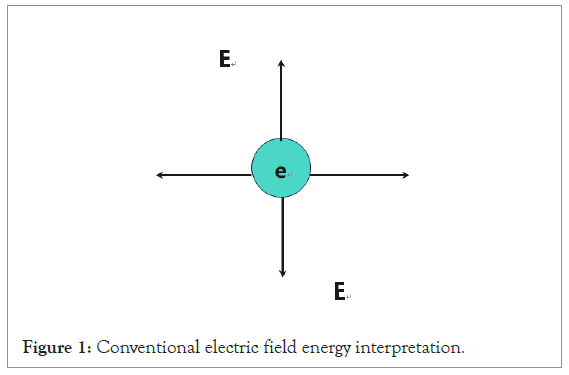
Figure 1: Conventional electric field energy interpretation.
According to our current theory, the electric field E will fill the whole space. Then, the connection between the electric field E and the electron has the following two possible cases:
Case 1: The electric field E and the electron e are independent of each other.
Case 2: The electric field E and the electron e are closely connected and inseparable from each other.
When we accelerate the electron e, if it is “Case 1”, then we will only accelerate the electron e, and the electric field E will not accelerate with the electron. According to the phenomenon we have observed, the accelerated electron e will immediately produce a “new field” to fill the whole space. So in the process of electron acceleration, there is no doubt that almost infinite energy is needed to replenish and fill the “new field”. At the same time, we need to explain many other dilemmas: Where is the “field” that is separated from the electron during acceleration? If the “electric field” has energy and mass, do they disappear or eventually flow back to the electron? If the energy of the electric field flows back, what is the process?
Obviously, if electrons and electric fields are independent of each other, we will encounter great difficulties in explaining physical phenomena.
If it is “Case 2”, then when we accelerate the electron E, the electric field E will accelerate with the electron. But we will still face many difficulties in the process of explanation. As an electric field E with energy and mass (with inertia), it fills the whole space. How can it accelerate and decelerate with the electron e instantaneously? In addition, we also need to explain how the “electric field energy E” of the whole space returns to the electron and proton instantaneously in a short time when the electron and proton attract each other.
In short, whether it is “Case 1” or “Case 2”, we have actually encountered great difficulties in interpretation and application.
Dilemma in the interpretation of gravitational field
1. If we replace the example of electric field with gravitational field, we will face more difficulties. Because gravity fills the whole universe, and if we consider the matter gravity of the whole universe as a whole, the accompanying gravitational field energy of any object with a static mass of m will be far greater than its own static energy:mc2.
If the gravitational field is closely connected with matter, we do not find the energy of this huge gravitational field in the process of accelerating matter.
Therefore, according to the traditional theory, we think that electric field, magnetic field, gravitational field and so on have substantial energy, momentum and inertia, which will encounter great trouble, at least we need to supplement a large number of theories to make up for this defect. It is more reasonable to think that all “fields” do not have energy, but it is more reasonable.
2. According to current theory, if the gravitational field exists in the form of gravitons and travels at the speed of light, then the gravitational redshift will not exist. Because the photon moves away from the gravitational field at the speed of light, the relative motion speed relative to the graviton will be 0, then the gravitational field will not be able to have any gravitational effect on the photon.
Discuss the way energy exists and the nature of the field: We make the following two assumptions:
Assumption 1: We assume that all matter has a minimum static mass m0.
Assumption 2: All energy in the universe comes from the energy m0 corresponding to the static mass of matter m0∙c2; and the energy m(v) caused by the relative motion between substances, where

If we follow these two assumptions, there will be some interesting new changes in our energy conservation formula and momentum conservation formula.
Discussion on the rationality of the assumption of minimum static mass m0
Discussion on photon Doppler shift in the universe: At present, we can observe the light emitted by stars tens of billions of light-years away, and we know that the Doppler redshift effect is ubiquitous (Figure 2).
Figure 2: Doppler shift in the universe.
Since the stars are far enough away, we can assume that they are moving away from the Earth in a straight line on a large scale, so their Doppler redshift formula is as follows:

Where ω0 is the frequency of the photon as it leaves the star; ω1 is the frequency of the photons observed by Earth observers; V is the relative velocity of our earth with respect to the stars.
Assuming that the speed of light C is a constant and definite value, the frequency of photons seen by an observer on Earth in the Doppler shift formula ω1 it depends on the relative velocity V between the Earth and the star and on the initial frequency of the photons ω0. The Doppler shift function can therefore be assumed to be:

Since we assume that the speed of light C is constant and therefore the same for photons of any frequency, we cannot distinguish the difference between any two different photons by C.
Therefore, the above Doppler shift function will become:

Therefore, at the initial frequency of the photon ω0 once determined, the Doppler shift effect depends only on the relative velocity of motion V.
However, we know that the distance between stars in the universe is very far, hundreds of millions of light-years or even billions of light-years. When photons reach the Earth, the speed of the luminous planet A away from the Earth has already changed, and even the planet A no longer exists. Therefore, the “information” of the initial velocity V of A relative to the earth must be “carried” by photons all the time. Otherwise, the frequency value of the Doppler shift effect cannot be determined when the photon comes to the earth and is observed ω1.
And the photon is not sure what object it will be absorbed by on the way of propagation, and with the passage of time, the relative velocity between objects in the universe is changing, so V cannot be a fixed and definite velocity, but a relative velocity function relative to all possible objects, and it is changing with the passage of time. Therefore, we can assume that this velocity information function for photons is:

Where X is the range of all possible matter in the universe that the photon may encounter, VAX represents the relative velocity of motion between the initially luminous star A and all the matter X that may be encountered; The t refers to the time, because VAX it is not a fixed value, but will change with the passage of time t.
Therefore, the range of values of (X,t) will be an infinite set, and it needs to be constantly changing with the change of time t. Then, the information carried by the photon will be an infinite set function related to t. It is hard to imagine that a tiny photon can carry an infinite and constantly changing “information set (X,t)”. This is not reasonable.
Therefore, we can infer that the speed of all photons is a constant C, which is an unreasonable assumption.
If we assume that any photon has a minimum initial mass m0. The energy of a photon is given in terms of the relativistic kinetic mass formula as follows:
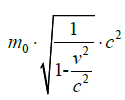
However, having an initial minimum mass m0 an important advantage of the assumption is that the velocity of the photon is not a constant value C, but a velocity V that approaches the constant value C indefinitely (v ≈ c).
Then, in the process of photon propagation, similar to the general matter with mass, it will have a self-determined velocity V, so that no matter what object is absorbed in the process of photon propagation, its relative energy will be determined by the relative velocity between photon and object. The Doppler shift function become a conventional relativistic transformation formula (this can be easily proved by the relativistic transformation formula, which will not be discussed too much here).
Discussion on the behavior of photon in gravitational field: As shown in the Figure 3, we know that light will be bent when it passes through the gravitational field, and Doppler gravitational blue shift will occur at the same time:
Figure 3: Gravitational blue-shift of light passing through gravitational field.
The force on the photon in the gravitational field is as follows (Figure 4):
Figure 4: Acceleration of light in gravitational field.
If we assume that the velocity of the photon is a constant C, assuming that the photon is moving perpendicular to the direction of the gravitational field at the beginning, the trajectory of the photon bends under the action of gravity, and the gravitational blue shift occurs. So according to our velocity synthesis formula, if the photon travels at a constant speed C, then gravity will not be able to accelerate it in the vertical direction. Since the photon is assumed to acquire a vertical velocity component V, the velocity of the photon will exceed the speed of light C (Figure 5).
Figure 5: The resultant velocity of light rays in the gravitational field.
The resultant speed will be:  , this would violate
our understanding that C is a constant. Therefore, according
to the velocity composition formula, we will consider that it is
impossible for a photon to acquire a vertical velocity component
V.
, this would violate
our understanding that C is a constant. Therefore, according
to the velocity composition formula, we will consider that it is
impossible for a photon to acquire a vertical velocity component
V.
But if we assume that the photon has a minimum initial mass m0, then the initial energy of the photon is:

The motion of photons in the gravitational field will be no different from that of ordinary matter, and they can also be accelerated in the vertical direction, and can also be calculated and analyzed by using the velocity synthesis theory.
Conclusion of this section: From the above analysis, we believe that any substance has a minimum static mass m0 it is reasonable, even for photons or neutrinos.
At the same time, we will also obtain the following inferences:
Conclusion 1: All fields, such as electric fields, magnetic fields, and gravitational fields, have neither energy nor mass.
Corollary 1: The conservation of momentum and the conservation of energy will change because this “field” does not have the nature of energy, and therefore there will be a series of “spatial effects”.
These spatial effects are the essence of the origin of the phenomena produced by all the “fields” we see. We will discuss this in more detail below.
When the field no longer has energy, the process of energy conservation will take the following form (taking the electric field as an example):
• Electron and proton combine and gain relative velocity, energy is conserved.
• When electrons and protons are separated, the kinetic energy decreases, the energy disappears, and the energy is in a transient non-conservation state Emissing, and produces the effect of force.
• Under the action of force and the evolution of time t, electrons and protons recombine and gain kinetic energy, and energy returns to conservation.
Unified theory of force
Conclusion 2: Electric field, magnetic field, gravitational field, etc. The “energy of field” obtained by matter through the action of field is limited.
Prove: Whether it is an electric field or a gravitational field, its energy is limited.
For example, Newton’s gravitational potential energy formula (1) and electric field potential energy formula (2) are as follows:
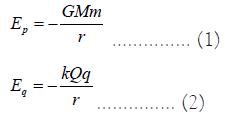
Where G is the gravitational constant,  . According to
the current theory, if r→0 tends to be infinitesimal, then the potential energy can be infinite.
. According to
the current theory, if r→0 tends to be infinitesimal, then the potential energy can be infinite.
However, the actual experimental conclusion is that this is not the case. If the electric field and gravitational field have the force under the infinitesimal radius, then the energy of the field Ep and Eq it goes to infinity. Then when the positive and negative electrons annihilate, the energy of the electric field and gravitational field will also be released.
However, in the actual process, we can see that the energy released by the annihilation of positive and negative electrons and protons is limited (and close to the energy corresponding to the static mass of positive and negative electrons and protons: me.c2 or mp.c2), basically corresponding to the static energy of matter.
Therefore, the energy of electric field or gravitational field
between positive and negative electrons and positive and negative
protons is limited. Therefore, the gravitational potential energy
formula  or the electric potential energy formula
or the electric potential energy formula  then r will be a finite value and will not tend to be infinitesimal.
Hence proved.
then r will be a finite value and will not tend to be infinitesimal.
Hence proved.
Conclusion 3: Since fields do not possess energy, our universe may exhibit a state of “energy non-conservation,” or Emissing state, in local regions or over time. It is precisely because of the nonconservation of this energy in a local area or a certain period of time, that there is an interaction force between substances, which finally makes the substances move with each other and the energy returns to the conserved state.
Taking the electric field as an example, our current measured electron mass, proton mass and calculated hydrogen atom mass is as follows [3-5]:
Electron mass (unit u): me=0.000548579
Proton mass (unit u): mp=1.007276466
Mass of hydrogen atom (unit u): mH=1.007825032
So, me+mp=1.007825045>mH
This conclusion seems to be contrary to our hypothesis; it seems that the sum of the mass of the electron me and the mass of the proton mp is exactly equal to or even greater than the mass of the hydrogen atom mH. And this just confirms the traditional view: “The field has energy and mass”.
However, it should be pointed out that the mass of the measuring electron must be its static mass me; to measure the mass of the proton, it must also be measured at static mp. A reasonable way is to measure the mass at Static by the annihilation of positive and negative electrons and protons, minus the kinetic energy due to the electric field.
Our current measurement methods are carried out separately, which will cause measurement errors due to the “cosmic forbidden energy arbitrage” we pointed out later, and the final measurement results are not the real masses of electrons and protons at Static me and mp. (It will be pointed out later that it cannot be measured by weighing method, which is also based on the theory that the universe forbids energy arbitrage).
Therefore, we will explain this theory in detail later. If we use the matter-antimatter annihilation method to accurately measure the static mass of electrons, protons and hydrogen atoms, then there must be the following relationship:
mH>me+mp
Where it is assumed that
Δm=mH-(me+mp)
So ΔE=Δm∙c2 it is the kinetic energy gained by the attraction of electrons and protons.
This means that before the electron and the proton actually combine, ΔE this part of energy is missing, and the energy of our universe is not in a state of conservation. It is not until electrons and protons combine that the state of energy return and conservation is finally reached.
Conclusion 4: The conservation of energy in the universe is realized under the time dimension of t, and it is not required that our universe maintains the state of energy conservation at any time t.
The conservation of energy under the time dimension is to realize the return and conservation of energy through the interaction between substances through the “missing energy field”, which eventually transforms into mutual movement.
For example, suppose the Static mass of the Earth is mA, the Static mass of the neutron star is mB. When the Earth and the neutron star are far apart, the total static mass we see at this time is mA+mB. If the Earth were being pulled into the neutron star, then we would see that their total mass would be greater than mA+mB.
This part of “missing gravitational energy” is the essence of gravity. This “missing gravitational energy” will return and realize the energy conservation of the universe only after it is transformed into the mutual motion of matter through the action of gravity on the dimension of time t.
Conclusion 5: The origin of the interaction of all forces in the universe is caused by the “missing energy field” caused by the missing of this energy (some effects are indirect effects). Matter can release or absorb some energy to change the missing of energy between matter, and then produce the interaction of field and force.
If two substances A and B are in an unconserved state of “missing of energy”, there will be a force between them. In turn, if there is no missing energy between two substances A and B, such as two uncharged neutrons, there will be no force action at a long distance. (Of course, some forces act indirectly through this missing of energy: The same charge repulsion effect, the close interaction of neutrons with nuclei, the interaction of photons with electrons, and so on.)
Matter can increase or decrease the total amount of energy loss between each other by increasing or losing energy (but not unilaterally). The absence and return of energy on the dimension of time t is the essence of the interaction between matter.
Electric field: When electrons and protons are separated, the total energy is less than the combined energy me+mp<mH.
As a result, energy is in a “missing of energy” state (or nonconservation state) at the time of separation, and then an electric field is generated, and then the electric field generates force and attracts each other and generates relative motion, eventually returning to the state of energy conservation.
Gravitational field: Similar to electric field.
Magnetic field: In fact, the magnetic field is also generated
by the missing of energy. When the electric field pushes the
electrons in the conductor to flow, because the electrons in the
conductor are very slow, the total kinetic energy of electron drift
under the action of the electric field in the conductor is far less
than the energy of the electric field itself:  it refers
to the kinetic energy of electron drift, E is the electric field
energy), so when the electric field energy is transmitted through
the conductor, there is a “missing of energy” state, which in turn
produces a magnetic field. This will be discussed in detail in
subsequent applications.
it refers
to the kinetic energy of electron drift, E is the electric field
energy), so when the electric field energy is transmitted through
the conductor, there is a “missing of energy” state, which in turn
produces a magnetic field. This will be discussed in detail in
subsequent applications.
Strong force: Take neutrons and protons in the nucleus as an example, there is no energy missing between neutrons and protons, so there is no long-distance direct interaction force between neutrons and protons. The strong force is formed by the following form:
We assume that the static masses of neutrons and protons when they exist alone are mn and mp, respectively. After they release energy E, the static masses of neutrons and protons become m'n and m'p after releasing energy. The energy of is E=Δmc2.

So we are in a state of non-conservation of energy, and we have two new particles m'n and m'p. This creates a state of missing energy (a state of non-conservation) ΔE. And then produce an energy field, they will attract each other and combine into a nucleus through the action of this “field”, and the particles will move with each other in the nucleus (quarks move with each other at a high speed). The missing energy ΔE is compensated by the mutual movement of m'n and m'p, and finally m'n and m'p are combined, which is the origin of the nuclear force. The resulting field is the force field.
Of course, in theory, it can also be achieved by adding energy:
Add energy E between neutron mn and proton mp, assuming that the static mass of the new particle after adding energy is mn + and mp + respectively, if:
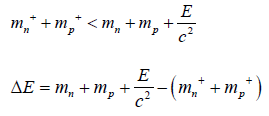
Then this creates a “missing energy ΔE” between mn+ and mp+, which in turn generates an energy field. They will attract and move each other through the action of this field, and make up for the missing energy by the mutual movement.
Conclusion 6: The total amount of missing energy Emissing between any two substances A and B is finite, and the force of
all fields produced by the missing energy Emissing obeys the inverse
square law of force in space:  , the radius r of its minimum
force is determined according to the total amount of energy loss.
We assume that the energy-missing equilibrium radius is r, then
there will be an attractive force between substances in the range
greater than r, and a repulsive force will be shown in the range
less than r. This is also the essential reason why the extra nuclear
electrons can be stable and not collapsed.
, the radius r of its minimum
force is determined according to the total amount of energy loss.
We assume that the energy-missing equilibrium radius is r, then
there will be an attractive force between substances in the range
greater than r, and a repulsive force will be shown in the range
less than r. This is also the essential reason why the extra nuclear
electrons can be stable and not collapsed.
The origin of the inverse square law of matter in space, including magnetic field, electric field, gravitational field and strong force
field (the reason why we cannot observe the inverse square law
of strong force will be explained below), is essentially due to the
missing of energy Emissing. And the action of the generated field,
the principle of their generation is the same, so they also follow
the inverse square law of force in space  .
.
All the phenomena of “force” caused by the missing of energy and the action of “force” in space conform to the inverse square law:

Taking electrons and protons as examples, the minimum radius of action of their attraction depends on the size of energy loss, and will not still have the effect of attraction on the infinitesimal scale, otherwise there will be infinite energy.
We assume that the total amount of missing energy between electrons and protons at larger distances is E, then according to the formula of electric field potential energy, the minimum attractive radius of its electric field r for
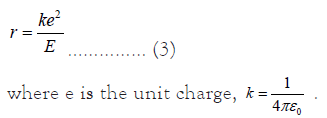
Of course, at the same time, we can see that atoms can increase or decrease the total amount of energy lost between each other by absorbing energy or releasing energy outward, and increase or decrease the speed of mutual movement to maintain their relatively stable state.
Therefore, we can well explain the following phenomena:
When the distance between the electron and the proton is greater than the radius r. The force between a proton and an electron follows the inverse square law, but when smaller than the radius r. This force becomes a repulsive force (from the electron scattering experiment, it should indeed be a repulsive force at close range [6]). Because of the missing energy between the electron and the proton, it is only necessary to return to conservation at the radius r. Therefore, the attraction between the electron and the proton will only occur at radii greater than or equal to r. When the radius is less than r, the nature of space makes the action of force repulsive.
It may be puzzling that the strong force in the nucleus does not seem to follow the inverse square law, it is only due to observation.
As mentioned above, we assume that the static masses of protons and neutrons are mp and mn, respectively, and they have the following relationship when combined into a nucleus:

Where E12 represents the energy of mutual attraction and mutual motion caused by the “missing of energy” when protons and neutrons combine. The strong force is caused by E12 due to the missing of energy. Δm it's the mass they lose when protons and neutrons combine. m'p and m'n it is the static mass of new particles after the release of energy when protons and neutrons combine.
When we try to observe the nucleus with a high-speed particle A (such as a neutron or proton), in fact, the difference between the observed particle A (neutron or proton) and the observed nuclear particle “m'p or m'n”, during this time, the so-called “energy-missing Emissing” state is not formed. So apart from the repulsion we can see between the charge between A and the nucleus, we can’t observe other forces at larger distances (for example, neutrons are largely unaffected when they are closer to the nucleus at longer distances) [7]. It is precisely because of this that the strong force is expressed as a short-range force, and in fact the weak force is also the same.
The so-called short-range force: That is, there is no energymissing Emissing state between the particle used for observation and the observed particle, so there is no “remote force of the field”. It is only an indirect force caused by the homogeneity of particles at a very close distance.
When they are very close, the effect at this time is not actually due to the direct force between the protons or neutrons used for observation and the nucleus, but because of the “identical property of particles”, which makes the close particles have a replacement relationship with the internal particles.
At the same time, we observe the phenomenon of strong “rubber band”, which has a very strong force in a small range, and this force disappears instantaneously after a certain distance.
Its essence is actually: If the kinetic energy of the particle A we
use for observation is Ew, and if  , after the nuclear
particles absorb the energy carried by the “observing particle”, it
will cause the particles inside the nucleus to interact with each
other. This “energy-missing Emissing” state disappears instantly,
and then becomes a “no energy-missing” state between two
protons or neutrons, which is also the reason why the nuclear
force is a short-range force in our opinion. While we know that
protons and neutrons are composed of smaller quarks, if we
approximate the atomic binding energy as the missing size of its
energy (about 2-9 MeV) [7], then according to the inverse square
law we can predict that the quark will behave the radius will be
very small.
, after the nuclear
particles absorb the energy carried by the “observing particle”, it
will cause the particles inside the nucleus to interact with each
other. This “energy-missing Emissing” state disappears instantly,
and then becomes a “no energy-missing” state between two
protons or neutrons, which is also the reason why the nuclear
force is a short-range force in our opinion. While we know that
protons and neutrons are composed of smaller quarks, if we
approximate the atomic binding energy as the missing size of its
energy (about 2-9 MeV) [7], then according to the inverse square
law we can predict that the quark will behave the radius will be
very small.
Supplementary conclusion: Our cosmic space seems to be inclined to keep the missing state of energy balanced or even precise in space.
1. In the case of electric charges, there is no “missing of energy” between the same charges, but our universe seems to tend to prohibit the “aggregation” of the same charges, thus showing the role of repulsive forces.
2. Taking the electrons outside the nucleus as an example, when the radius is less than the R required for energy loss, the charges seem to turn into repulsive forces, thus maintaining the strictness of the inverse square law of energy loss in space. This phenomenon seems to be the opposite of the attraction caused by the missing of energy.
For example, two electrons will slow down in the process of approaching, and their total energy will decrease, which will lead to the formation of “energy loss” state between them, and then produce repulsive force, which will eventually lead to the return of energy.
Conclusion 7: The universe prohibits energy arbitrage, and our universe is energy-conserving on the time t dimension.
Proof: For an electron and a proton, we assume that their masses at Static are me and mp, the mass of the hydrogen atom at the time of merger is: mH=me+mp+Δm.
So when we accelerate electrons and protons alone, if we only need to consume the corresponding Static mass me and mp energy required, then the total energy before acceleration is mH (Including the missing energy part Δm).But if we separate them first, we accelerate the electrons and protons to V, and then let them attract each other and merge, we will get the total mass (kinetic mass):

And the energy E we spend accelerating electrons and protons alone corresponds to the mass of their Static state me and mp. Therefore, the energy consumed by the acceleration process is:

Then we will gain extra energy before and after acceleration, thus realizing “energy arbitrage”, resulting in energy no longer being conserved:

Then it means that the energy of the universe increases before and after acceleration, which is forbidden.
Therefore, we have an important corollary:
Corollary: Electrons and protons will generate a “accompanying energy field: Efollow” during acceleration to ensure energy conservation before and after acceleration.
Positive and negative electron annihilation, positive and negative proton annihilation can be used to measure the size of its accompanying energy field. Because it is possible that the distribution of this “accompanying energy field” between electrons and protons is asymmetric.
At the same time, the “accompanying energy field: Efollow” it is also the origin of energy radiation of electrons and protons.
Whether it is the X-rays (bremsstrahlung) emitted by the highspeed electrons that we discovered hitting the nucleus, or the synchrotron radiation we currently use to generate high-speed electrons, the essence is that the charged particles generate an “accompanying energy field: Efollow” during the acceleration, which in turn causes the phenomenon. Because the binding force between the associated energy field and electrons or protons is relatively weak, and Efollow has real mass, momentum and inertia, when the moving electrons collide or change direction, Efollow will be easily radiated due to inertial effect, accompanied by the deceleration of charged particles.
It should be noted that the observer’s perspective of the accompanying energy field is in a relatively static ground observer’s reference frame. This accompanying energy field is invisible to an observer moving with the electrons. Because the reason for the generation of the associated energy field is based on the conservation of energy.
It is also true that we do not observe the radiation of neutrons, because there is no accompanying energy field around the moving neutrons Efollow.
In addition, the missing of energy due to gravity does not produce this effect, because the energy (mass) of an object is directly related to its speed. Accelerate a static mass of m object A, assuming that its energy (kinetic mass) after acceleration becomes m(v). Then it means that the energy of the gravitational field corresponding to object A will increase proportionally and there will be no “arbitrage phenomenon” of energy.
Conclusion 8: The distribution of missing energy made up of particle populations can be uneven. Taking the electron outside the nucleus as an example, the energy of the outermost electron is not the missing energy of the average electron and proton. After losing the outer electron, the atomic radius will shrink a lot, and this is the reason [7].
At present, we are not sure whether the larger elements in the periodic table change the total amount of energy loss between particles through the release of energy between neutrons and protons during the formation of their nuclei, or whether the total amount of energy loss between protons in the nucleus and electrons outside the nucleus is also changed through the release of energy. On this point, we need further experimental verification.
Conclusion 9: The state of energy missing can be reduced or increased by the release of energy between substances (for example, the outer electrons of atoms radiate energy); the amount of this missing energy can also be changed by absorbing energy.
Application of the unified theory of force
The “arrest” phenomenon of charged particle acceleration and the origin of its radiation
1. We find that it is difficult to accelerate charged particles, and the phenomenon of energy radiation will appear when the charged particles are accelerated.
We assume that the electron mass at static is me, the proton mass at static is mp, the mass of a hydrogen atom when the electron and proton combine (without radiating energy) is mH, and has the following relationship:

When we accelerate electrons or protons, we actually not only accelerate the particles corresponding to their static masses me or mp, but also because the universe prohibits “energy arbitrage”, there will be an associated energy field Efollow generated.
For example, we assume that a stationary electron and proton are separately accelerated to v the amount of energy E that we actually need to expend is:

Therefore, in fact, in the process of accelerating electrons and protons, besides the energy increased by the speed increase of their own static mass, there will also be an accompanying energy around them, whose magnitude is:

Therefore, if the moving electron collides with a massive atomic nucleus, this part of the accompanying energy will be released due to inertial action, and the maximum value of its single radiation energy is Efollow, that is, the maximum energy of a single photon is radiated for Efollow. (The exact maximum radiation value is determined according to the distribution of Efollow between electrons and protons, and if it is equally distributed, then its maximum radiation value is Efollow/2).
2. For synchrotron and bremsstrahlung: In our traditional theory, synchrotron radiation is considered to be a relativistic effect phenomenon. In fact, the author has explained in two other articles that there is no such relativistic effect [1,2]. However, we use the accompanying energy field to explain the phenomenon which is actually more natural and consistent with the experimental observation.
An electron moving in a straight line at a high speed has a velocity of v1 after the moving direction is changed by a strong magnetic field, the moving speed is v2, assuming that we do not consider the time of the angular transition of the electron velocity (if the time is small), then the accompanying energy Efollow it will be radiated in the form of a straight line, and the amount of energy radiated is:
The total energy of the particle before passing through the magnetic field is:
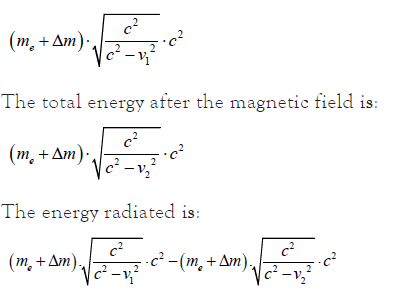
Where Δm assume for us the magnitude of the accompanying energy around the electron, which is in the range of (0, mH-me- mp), we guess that its size is: (mH-me-mp)/2, but experimental evidence is needed.
In theory, if there is no accompanying energy Efollow, just changing the direction of movement of the electron will not radiate energy, only the momentum of the electron has changed, and the energy before and after is conserved.
For example, if we do the same acceleration for neutrons, since there is no accompanying energy for neutrons, there will be no such radiation effect.
3. The forces due to missing energy can be superimposed, but the total amount of missing energy will not be increased.
For example, if 10 electrons and 10 protons are separated, if the unit attraction of 10 protons to an electron increases by 10 times at the same distance, it does not mean that the overall energy loss increases, which is still 10 times the energy loss between an electron and a proton.
Interpretation and application of magnetic field
1. Our current theory holds that the magnetic field is generated by the moving charge or changing electric field in the conductor. We’re going to restate it here, the magnetic field is actually a phenomenon caused by “energy-missing Emissing”, which has exactly the same origin as the electric field.
We illustrate with the following thought experiment:
Assume that that capacitance of a capacitor I4 μF charged to a voltage of 600 V, the stored energy is:
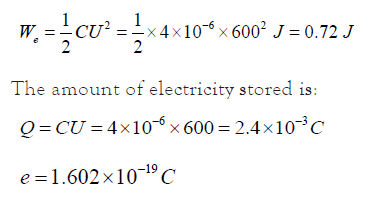
The total number of electrons corresponding to the estimated stored electricity is:

If converted into the kinetic energy of the electron, the velocity of the electron is approximately:
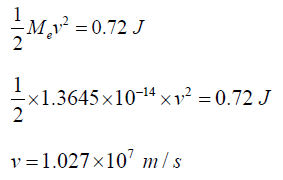
We assume that a superconducting coil is connected between the two capacitor plates, and electrons will pass through the coil without resistance. We know that the speed of electrons in ordinary wires is generally less than 1 m/s [8], and even in superconducting coils, the speed is expected to be much less than 107 m/s. (Note: Because the current density of general superconducting materials can reach 200 ~ 1000 A.mm-2, is 100- 1000 times that of the non-superconducting state, so we roughly estimate that the electron drift velocity in superconductors is 100-1000 times that in ordinary conductors, assuming that the number of free electrons is constant.)
Then, in the process of converting the electric field into electron kinetic energy, since the electron kinetic energy is not equal to the electric field energy (1/2 Mev2 ≪ Eq), the “missing” energy will exist in a state of “missing energy”, which forms the magnetic field we see, which is the origin of the magnetic field.
In fact, all magnetic fields, including the magnetic moment caused by the spin of particles, are a manifestation of the missing of energy, and also indicate that the electron e actually has a more microscopic internal structure.
2. The modification of the displacement current in the traditional Maxwell electromagnetic theory (Figure 6).
Figure 6: Maxwell displacement current.
In traditional electromagnetism, in order to explain the magnetic field formed between two charged capacitor plates (the magnetic effect of the part enclosed by the closed surface S2), Maxwell proposed a concept of displacement current and its magnetic effect [9].
In fact, this is not necessary, the traditional electromagnetic theory believes that the current generates the magnetic field, but it has not been recognized that the essence of the magnetic field is not the current, but the missing of energy in the process of current conduction Emissing. Therefore, there is no need for an additional assumption that the displacement current produces a magnetic effect.
3. Magnetic monopole
According to the missing energy theory, the magnetic monopole does not exist.
4. The experiment predicts that a strong magnet (or electron magnetic moment) moving at a high speed will radiate energy like an electron when it suddenly changes its direction of motion or collides.
Similar to electrons and protons, slowing down or changing the direction of a high-speed magnet will also radiate energy. Otherwise, the phenomenon of “energy arbitrage” will occur.
Therefore, when we accelerate the magnet, an accompanying energy field Efollow is generated near the magnet, so that energy arbitrage does not occur. Its radiation formula is the same as when the electrons or protons collide or accelerate as described above.
At the same time, because the electron e has a very small spin and magnetic moment, in experiments such as synchrotron radiation, we should also be able to detect a very small radiation, which is generated by the “companion energy” of the electron spin magnetic field.
Interpretation of the gravitational field
On the characteristics of gravitational energy: As shown in Figure 7, we assume that the initial masses of the A and B balls are respectively m+Δm. The initial masses of C and D balls are respectively M+ΔM. At the beginning, the four spheres are relatively static and far apart, and the S system is assumed to be the ground observer.
Figure 7: Gravitational potential energy thought experiment.
The A and B balls burn the energy corresponding to the mass of Δm, respectively, and convert them into the relative motion speeds of the X-axis direction of the S system -v1 and v1. The energy corresponding to the mass of ΔM is burned by the C and D balls, respectively, which is converted into the movement speed relative to the X-axis direction of the S system -v2 and v2.
At the beginning, it is assumed that the gravitational potential energy between A,C is E1 and B,D is E1 too.
Since the acceleration process is only the transformation of the static mass of the object into the dynamic mass of the object, if A and C are regarded as a whole, B and D are regarded as a whole. From the point of view of the S system, the mass and energy are conserved before and after the acceleration, and the masses of A,B,C and D have not changed, so the energy is conserved before and after. And the gravitational potential energy between A,C and B,D is E1 also unchanged.
When v1=v2=v,the gravitational potential energy seen from the S system will have the following relation:
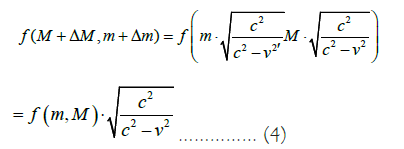
We find that the left and right sides of (4) are actually a gravitational potential energy function related to the total energy. Instead of the following formula for gravitational potential energy, which we often use:

Because in the traditional theory of gravitational potential energy, if r is kept constant, equation (5) is a function related to the product of total energy “M.m”, rather than a function related to total energy.
For the gravitational magnitude:  . It is easy to
understand that this is similar to the superposition property
of electromagnetic force. When charges accumulate, the
magnitude of their forces can be superimposed, so the formula
of gravitation between two objects does not need to be modified.
. It is easy to
understand that this is similar to the superposition property
of electromagnetic force. When charges accumulate, the
magnitude of their forces can be superimposed, so the formula
of gravitation between two objects does not need to be modified.
However, the total amount of energy missing between the two electric fields does not increase because of the superposition of forces, which is also in line with the characteristics of gravity. Therefore, we believe that the total amount of gravitational potential energy between discrete matter is a function related to the mass of the whole matter.
Therefore, we conclude that:
Conclusion 10: Gravitational potential energy between uniformly discretely distributed matter E the magnitude of is actually a function related to the total energy of matter and scales linearly with M and m:

This is similar to the total energy of the electric field, the total energy of the missing electric field of a pile of free positive and negative charges is directly related to the total number of positive and negative charges.
However, the difference between gravitational field and electric field is that we find that after any two substances A and B attract each other and combine through gravity, the gravity between AB and other substances does not disappear, but continues to exist. This property of gravitation is completely different from the property that electrons and protons in an electric field no longer exhibit an electric field after they combine.
Therefore, we can deduce another conclusion of the gravitational field:
Conclusion 11: The total gravitational energy depends on the sum of the gravitational energy between the matter.
We assume that there are 2n substances with a static mass of Δm that are uniformly and discretely distributed in the universe, and we consider them to perform a pairwise merger process uniformly:
Two Δm total energy after merger:

Where we assume  . It is the mass expression of the
energy of the gravitational potential energy between two objects
after their merger.
. It is the mass expression of the
energy of the gravitational potential energy between two objects
after their merger.
Two of the above m1 re-merging of objects:

Which,  representing two masses of
representing two masses of  the static mass of the gravitational potential energy
produced by the merger between objects. And so on:
the static mass of the gravitational potential energy
produced by the merger between objects. And so on:
Continue to merge two m2:

Obviously, there are:

If we assume:

Then according to equations (6) and (7), we have the following relation:
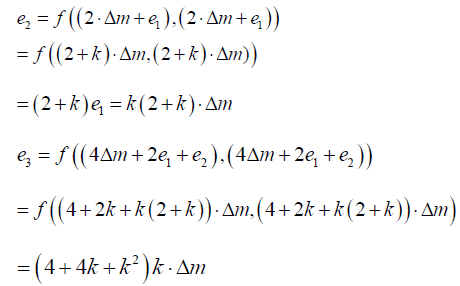
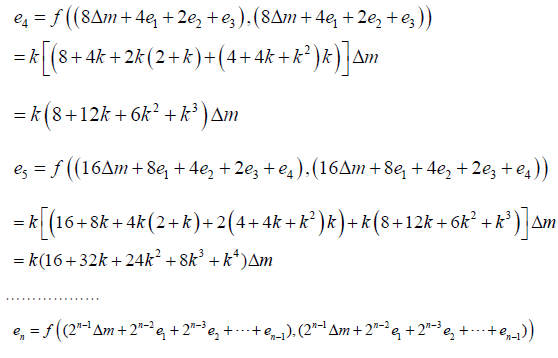
Thus, the coefficient of the kΔm term in en is: 2n-1
The coefficient of the k2 Δm term in en is:

The coefficient of the k3 Δm term in en is:
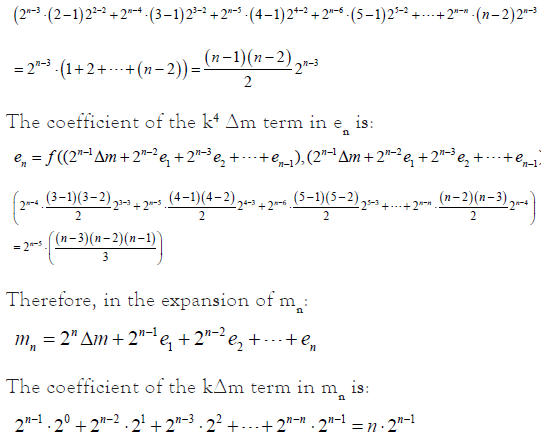
Therefore, when nk>2, there is:  , the
growth rate of gravitational potential energy in the first term
of the coefficient
, the
growth rate of gravitational potential energy in the first term
of the coefficient  , it will be greater than the
growth rate of visible matter mass we see by 2n.Δm .
, it will be greater than the
growth rate of visible matter mass we see by 2n.Δm .
The coefficient of the k2 Δm term in mn is:

If  , that is, when: n(n-1) k2>8, the
gravitational potential energy of the k2 Δm term will increase
faster than the mass of matter. (When n is large enough, it is
approximately equal to n2 k2>8, that is,
, that is, when: n(n-1) k2>8, the
gravitational potential energy of the k2 Δm term will increase
faster than the mass of matter. (When n is large enough, it is
approximately equal to n2 k2>8, that is,  ).
).
The same calculation applies to the k3 Δm term coefficients in mn:
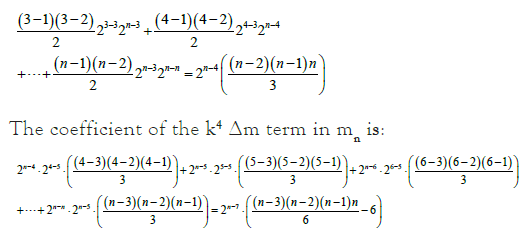
So we come to the following conclusion:
Conclusion 12: When the amount of matter such as stars in the universe gradually increases to a certain amount, the increase rate of energy brought by gravitational potential energy will exceed the increase rate of the mass of visible matter such as stars, namely:

The above model is very suitable for our current cosmic space. The distribution of stars and other matter in our galaxy, the distribution of galaxies in the universe, and the symmetry and flatness of the universe we observe are all very suitable for the analysis of this model. Because k it is a fixed coefficient we assume, so in our galaxy or universe, when the total amount of uniformly distributed matter is greater than a critical point, the increase in energy per unit of matter (such as stars in the galaxy) will be several times or even tens of times the mass of the matter itself.
Conclusion 13: The gravity we observe in galaxies is not caused by the total amount of matter mass we see on the surface, but rather by its true total energy. Therefore, the problem of the galaxy rotation curve we see is actually not generated by dark matter, but by the total energy generated by the mass of the matter itself and the gravitational force between the matter.
Proof: According to our cosmic forbidden energy arbitrage theorem.
As shown in the Figure 8, we take the sun as an example, if the matter inside the sun expands on average to n times to nR the current radius of the sun. At this time, due to the matter overcoming gravity to do work, the static mass of the sun before the expansion is assumed to be MR, and the static mass after the expansion is MnR. Since the work is done overcoming the gravity, there is: MnR<MR.
Figure 8: Gravity thought experiment.
There is a substance A with mass m at the edge of nR, and we can prove that its gravitational force FR before and after the expansion of the sun is unchanged, although it seems that the static mass MnR of the entire sun after the expansion becomes smaller.
Contradictory method: If the solar gravitational force FR received by A becomes smaller after the expansion of the sun, the assumption becomes FnR, and FR<FnR. Then we can overcome gravity with a certain amount of energy and fly to infinity after expansion, and then fly back (free fall) after the sun shrinks, then the energy of the entire system before and after increases.
Conclusion 14: Similar to the superposition of electric field force, the gravitational force generated by matter energy can also be superimposed.
Conclusion 15: When matter is accelerated, gravity does not have an accompanying energy field like electromagnetic force.
Because the kinetic mass of matter after acceleration m(v) it directly corresponds to the total energy of matter, as well as the size of gravity and the missing gravitational mass. There will be no problem of energy arbitrage.
Application of gravity theory
An explanation for the flattening of galaxy rotation curves: Through the previous argument, we know that the gravitational effect of stars in galaxies is not actually caused by the total static mass of visible matter in galaxies, but should include the “missing gravitational energy”.
As the mass of matter in galaxies increases, we see that the increase in energy brought about by gravity will eventually exceed the growth rate of the static mass of matter itself. This is the core reason why the rotation curve of our galaxy looks smooth.
Structure of black holes: We start by assuming a massive smallradius star (black hole) with mass M and radius R.
According to Newton’s gravitational potential energy formula, it is as follows:

According to our conclusion, the energy missing from gravity is limited, so we assume that the added gravitational potential energy in the process of falling into the black hole M of an object of mass m is limited, which is given by the following formula:

Then we get the gravitational attraction radius r of the black hole M (when it is less than r, it will become a repulsive force):

If the radius of the black hole M itself R,R<r, namely:

Then in the process of matter being sucked into the black hole, like electrons, it will first be attracted by the gravitational force of M, and when it reaches a radius of r gravity will stop attracting, and then there will be repulsion.
Therefore, if the radius of a massive black hole satisfies the above condition (8), a “hole” will be created between the black hole and the attracted matter outside it, which will be like the hole between protons and electrons. The size of the “void” increases with the mass of the black hole.
For the formation of black holes themselves and gravitational waves: Like atomic nuclei, if the collapse of the black hole cannot be reduced to a very small radius r due to the missing of energy due to its own gravity, then if it wants to continue to collapse, it must release energy during the formation of the black hole to form a new “energy missing state”.
Therefore, we guess that during the formation of black holes with large mass and small radius, huge energy will be released. This energy will be released in the form of electromagnetic force or gravitational waves.
At the same time, we have proved another conclusion: Unlike the conclusion of general relativity, high-speed massive stars rotating around each other do not release gravitational waves, so it is impossible for us to explore the gravitational waves released by the rotation of binary stars.
Black holes do not have event horizon: According to the theoretical prediction of this paper, the gravitational potential energy between matter and black hole is finite, so any photon can escape from the “black hole”, but there will be a redshift effect. This redshift effect will be more significant for high-mass black holes than for low-mass black holes.
Applications in quantum mechanics
1. The explanation of why electrons do not fall into the nucleus is no longer explained by the traditional electron theory or the uncertainty principle.
Instead, it is more natural and theoretical to understand the phenomenon from the perspective of energy conservation and missing. The essential reason why electrons move outside the nucleus and do not fall into the nucleus is the conservation of energy, which itself exists in this way of relative motion.
2. Prediction of the internal structure of the electron
From the point of view of the magnetic moment of electrons, electrons should have a more refined internal structure. The existence of the magnetic moment represents the missing of energy between the substances moving with each other inside the electron. The existence of the magnetic moment of the electron and its existence without disappearance are actually the conservation state of maintaining this energy in the time dimension.
In this paper, two basic hypotheses are proved by logical reasoning: The field does not have mass and energy, all matter has the minimum mass and the energy of matter comes from relative motion. On this basis, a new set of mechanical theory is constructed in this paper, which unifies gravitation, electromagnetic force, weak force and strong force.
The new unified theory of mechanics can well answer many difficult questions in physics in the past: The common origin of the inverse square law of force, the origin of magnetic field, the rotation curve of galaxies, the origin of electromagnetic radiation, the nature of strong and weak forces and short-range forces, explaining that dark matter does not exist, and other related issues.
At the same time, this paper makes new predictions: High-speed magnets will also radiate energy, the real structure of black holes is similar to that of atomic nuclei and extranuclear electrons (showing repulsion at close range), the gravitational potential energy of black holes is limited (will not swallow photons), and celestial bodies will not radiate gravitational waves in high-speed rotation.
The traditional theory is revised: The problem of the minimum radius of action of the electric field theory and the gravitational theory, the energy function of the gravitational field, the origin of the magnetic field, the new interpretation of Maxwell’s displacement current, and Newton’s gravitational potential energy formula was revised.
Citation: Qin S (2022) Unified Theory of Gravity, Electromagnetic Force, Strong and Weak Forces and their Applications: Theoretical Explanation for Dark Matter. J Phys Chem Biophys. 12:335.
Received: 30-Sep-2022, Manuscript No. JPCB-22-19424; Editor assigned: 03-Oct-2022, Pre QC No. JPCB-22-19424 (PQ); Reviewed: 17-Oct-2022, QC No. JPCB-22-19424; Revised: 24-Oct-2022, Manuscript No. JPCB-22-19424 (R); Published: 31-Oct-2022 , DOI: 10.35248/2161-0398.22.12.335
Copyright: © 2022 Qin S. This is an open-access article distributed under the terms of the Creative Commons Attribution License, which permits unrestricted use, distribution, and reproduction in any medium, provided the original author and source are credited.